Typomorphic Characterization and Geological Significance of Megacrystalline Uraninite in the Haita Area, Kangdian Region, Southwestern China
Abstract
1. Introduction
2. Geological Background
3. Samples and Analytical Methods
4. Typomorphic Characteristics of Uraninite
4.1. Morphological Characteristics
4.2. Physical Properties
4.3. Crystal Structure
4.4. Chemical Composition
4.5. Mineral Assemblage
4.6. Valence State Characteristics
5. Discussion
5.1. Geological Significance of Uraninite Typomorphic Characteristics
5.2. Metallogenic Background and Genesis of Uraninite
6. Conclusions
- (1)
- Exceptional crystallinity and size. Naturally occurring uraninite exhibits well-developed euhedral morphologies with anomalously large grain sizes (≤10 mm).
- (2)
- High-temperature crystallization signatures. The typomorphic features reflect stable physicochemical conditions, indicating formation in a reduced environment (>450 °C) with gradual cooling.
- (3)
- Dual genetic controls. Mineralization is jointly governed by migmatization (uranium preconcentration) and tectonism (fluid pathways/ore deposition).
Supplementary Materials
Author Contributions
Funding
Data Availability Statement
Acknowledgments
Conflicts of Interest
References
- Molnar, F.; O’Brien, H.; Stein, H.; Cook, N.D. Geochronology of hydrothermal processes leading to the formation of the Au–U mineralization at the Rompas prospect, Peräpohja belt, Northern Finland: Application of paired U–Pb dating of uraninite and Re–Os dating of molybdenite to the identification of multiple hydrothermal events in a metamorphic terrane. Minerals 2017, 7, 171. [Google Scholar]
- Wu, Y.; Qin, M.; Guo, D.; Fan, G.; Liu, Z.; Guo, G. The latest in-situ uraninite U-Pb age of the Guangshigou uranium deposit, Northern Qinling orogen, China: Constraint on the metallogenic mechanism. Acta Geol. Sin.-Engl. 2018, 92, 2445–2447. [Google Scholar]
- Cheng, L.; Zhang, C.; Song, H.; Cheng, Q. In-Situ LA-ICP-MS Uraninite U–Pb Dating and Genesis of the Datian Migmatite-Hosted Uranium Deposit, South China. Minerals 2021, 11, 1098. [Google Scholar] [CrossRef]
- Zhong, F.; Yan, J.; Xia, F.; Pan, J.; Liu, W.; Lai, J.; Zhao, Q. In-situ U-Pb isotope geochronology of uraninite for Changjiang granite-type uranium ore field in northern Guangdong, China: Implications for uranium mineralization. Acta Petrol. Sin. 2019, 35, 2727–2744, (In Chinese with English Abstract). [Google Scholar]
- Xu, K.; Li, G.; Zhang, H.; Dong, W.; Liu, X.; Zhang, X.; Wang, R. Uranium and U-bearing minerals in the Husab uranium deposit in Namibia: Occurrence, composition, age, and implications for uranium mineralization process. Ore Geol. Rev. 2025, 182, 106642. [Google Scholar] [CrossRef]
- Macmillan, E.; Ciobanu, C.L.; Ehrig, K.; Cook, N.J.; Pring, A. Chemical zoning and lattice distortion in uraninite from Olympic Dam, South Australia. Am. Mineral. 2016, 101, 2351–2354. [Google Scholar] [CrossRef]
- Spano, T.L.; Simonetti, A.; Balboni, E.; Dorais, C.; Burns, P.C. Trace element and U isotope analysis of uraninite and ore concentrate: Applications for nuclear forensic investigations. Appl. Geochem. 2017, 84, 277–285. [Google Scholar] [CrossRef]
- Yuan, F.; Jiang, S.Y.; Liu, J.; Zhang, S.; Xiao, Z.; Liu, G.; Hu, X. Geochronology and Geochemistry of Uraninite and Coffinite: Insights into Ore-Forming Process in the Pegmatite-Hosted Uraniferous Province, North Qinling, Central China. Minerals 2019, 9, 552. [Google Scholar] [CrossRef]
- Ozha, M.K.; Pal, D.C.; Mishra, B.; Desapati, T.; Shaji, T.S. Geochemistry and chemical dating of uraninite in the Samarkiya area, central Rajasthan, northwestern India—Implication for geochemical and temporal evolution of uranium mineralization. Ore Geol. Rev. 2017, 88, 23–42. [Google Scholar] [CrossRef]
- Zhang, L.; Chen, Z.; Wang, F.; White, N.C.; Zhou, T. Release of uranium from uraninite in granites through alteration: Implications for the source of granite-related uranium ores. Econ. Geol. 2021, 116, 1115–1139. [Google Scholar] [CrossRef]
- Zhang, L.; Wang, F.; Zhou, T.; Zhu, J.; Cao, C. Metallogenesis of uranium deposits in China: Perspectives from uraninite chemistry. Ore Geol. Rev. 2024, 173, 106251. [Google Scholar] [CrossRef]
- Bowles, J.F. Age dating of individual grains of uraninite in rocks from electron microprobe analyses. Chem. Geol. 1990, 83, 47–53. [Google Scholar] [CrossRef]
- Alexandre, P.; Kyser, T.K. Effects of cationic substitutions and alteration in uraninite, and implications for the dating of uranium deposits. Can. Mineral. 2005, 43, 1005–1017. [Google Scholar] [CrossRef]
- Schmitt, A.K. Uranium series accessory crystal dating of magmatic processes. Annu. Rev. Earth Planet. Sci. 2011, 39, 321–349. [Google Scholar] [CrossRef]
- Pal, D.C.; Rhede, D. Geochemistry and chemical dating of uraninite in the Jaduguda Uranium Deposit, Singhbhum Shear Zone, India—Implications for uranium mineralization and geochemical evolution of uraninite. Econ. Geol. 2013, 108, 1499–1515. [Google Scholar] [CrossRef]
- Waitzinger, M.; Finger, F. In-situ U–Th–Pb geochronometry with submicron-scale resolution: Low-voltage electron-beam dating of complexly zoned polygenetic uraninite microcrystals. Geol. Carpath. 2018, 69, 558–572. [Google Scholar] [CrossRef]
- Corcoran, L.; Simonetti, A. Geochronology of uraninite revisited. Minerals 2020, 10, 205. [Google Scholar] [CrossRef]
- Song, H.; Xiao, T.; Chi, G.; Wang, Z.; Xu, Z.; Hou, M. CAUM: A software for calculating and assessing chemical ages of uranium minerals. Geosci. Front. 2025, 16, 102031. [Google Scholar] [CrossRef]
- Min, M.; Zhang, F. Genetic Uranium Mineralogy, 1st ed.; Atomic Energy Press: Beijing, China, 1992; pp. 1–354. (In Chinese) [Google Scholar]
- Yao, L.Y.; Zhang, B.J. Experimental Geochemistry of the Xiangshan Hydrothermal Uranium Deposit; Atomic Energy Press: Beijing, China, 2014; pp. 1–54. (In Chinese) [Google Scholar]
- Shen, C.Q.; Zhao, F.M. The experimental study of synthetic octagonal uraninite. Uranium Geol. 2014, 30, 252–256, (In Chinese with English Abstract). [Google Scholar]
- DeVetter, B.M.; Myers, T.L.; Cannon, B.D.; Scharko, N.K.; Kelly-Gorham, M.R.K.; Corbey, J.F.; Johnson, T.J. Optical and chemical characterization of uranium dioxide (UO2) and uraninite mineral: Calculation of the fundamental optical constants. J. Phys. Chem. A 2018, 122, 7062–7070. [Google Scholar] [CrossRef]
- Zhang, C.; Chen, Y.; Li, J.; Xu, Z.; Yao, J. The discovery of coarse-grained uraninite in Kangdian Axis and its geological significance. Geol. Bull. China 2015, 34, 2219–2226, (In Chinese with English Abstract). [Google Scholar]
- Xu, Z.; Yin, M.; Chen, Y.; Xiang, L.; Song, H.; Zhang, C.; Yao, J.; Guo, H. Genesis of megacrystalline uraninite: A case study of the Haita area of the western margin of the Yangtze block, China. Minerals 2021, 11, 1173. [Google Scholar] [CrossRef]
- Yin, M.; Xu, Z.; Song, H.; Zhang, C.; Zhang, S.; Tian, J.; Guo, H. Constraints of the geochemical characteristics of apatite on uranium mineralization in a uraninite-rich quartz vein in the Haita area of the Kangdian region, China. Geochem. J. 2021, 55, 301–312. [Google Scholar] [CrossRef]
- Wang, F.; Sun, Y.; Yao, J.; Ye, J. Study on characteristics of gaint grain uraninite in Haita area of Miyi county, Sichuan. World Nucl. Geosci. 2017, 34, 187–193, (In Chinese with English Abstract). [Google Scholar]
- Yin, M.; Zhang, S.; Xu, Z.; Song, H.; Chen, Y.; Yao, J.; Wang, F. Neoproterozoic uranium mineralization in the Kangdian region of the eastern Tibetan Plateau, China. Geosyst. Geoenviron. 2024, 3, 100135. [Google Scholar] [CrossRef]
- Pan, X.; Zhao, J.; Zhang, X.; Zheng, H.; Yang, X.; Zhou, G.; Tao, D. Teconics and Rifting in Kangdian Region; Chongqing Publishing House: Chongqing, China, 1987; pp. 13–15. (In Chinese) [Google Scholar]
- Zhou, M.F.; Zhao, X.F.; Chen, W.T.; Li, X.C.; Wang, W.; Yan, D.P.; Qiu, H.N. Proterozoic Fe–Cu metallogeny and supercontinental cycles of the southwestern Yangtze Block, southern China and northern Vietnam. Earth-Sci. Rev. 2014, 139, 59–82. [Google Scholar] [CrossRef]
- Song, H.; Chi, G.; Zhang, C.; Xu, D.; Xu, Z.; Fan, G.; Zhang, G. Uranium enrichment in the Lala Cu-Fe deposit, Kangdian region, China: A new case of uranium mineralization associated with an IOCG system. Ore Geol. Rev. 2020, 121, 103463. [Google Scholar] [CrossRef]
- Wang, D.Y.; Fu, Y.Q. Uranium Mineralogy, 1st ed.; Atomic Energy Press: Beijing, China, 1986; pp. 1–442. (In Chinese) [Google Scholar]
- Finch, R.; Murakami, T. Systematics and paragenesis of uranium minerals. In Reviews in Mineralogy; Mineralogical Society of America: Washington, DC, USA, 1999; Volume 38, pp. 91–179. [Google Scholar]
- Xu, G.Q.; Wang, A.Z.; Gu, Y.F.; Zhang, J.Y.; Zhang, S.M.; Huang, Y.Z. Some mineralogical characteristics of uraninte and pitchbleede in China. Acta Mineral. Sin. 1982, 3, 193–200, (In Chinese with English Abstract). [Google Scholar]
- Xu, Z.; Yin, M.; Song, H. Characteristics and Genesis of Megacrystalline Uraninite on the Kangdian Region, Southwestern China; Science Press: Beijing, China, 2024; p. 67. (In Chinese) [Google Scholar]
- Li, Z.; Huang, Z.; Li, X.; Fan, C. The discovery of natural native uranium and its significance. Acta Geol. Sin.-Engl. 2015, 89, 1561–1567. [Google Scholar]
- Clauer, N.; Mercadier, J.; Patrier, P.; Laverret, E.; Bruneton, P. Relating unconformity-type uranium mineralization of the Alligator Rivers Uranium Field (Northern Territory, Australia) to the regional Proterozoic tectono-thermal activity: An illite K–Ar dating approach. Precambrian Res. 2015, 269, 107–121. [Google Scholar] [CrossRef]
- Macmillan, E.; Cook, N.J.; Ehrig, K.; Ciobanu, C.L.; Pring, A. Uraninite from the Olympic Dam IOCG-U-Ag deposit: Linking textural and compositional variation to temporal evolution. Am. Mineral. 2016, 101, 1295–1320. [Google Scholar] [CrossRef]
- Ram, R.; Charalambous, F.A.; McMaster, S.; Pownceby, M.I.; Tardio, J.; Bhargava, S.K. Chemical and micro-structural characterisation studies on natural uraninite and associated gangue minerals. Miner. Eng. 2013, 45, 159–169. [Google Scholar] [CrossRef]
- Ram, R.; Charalambous, F.A.; McMaster, S.; Pownceby, M.I.; Tardio, J.; Bhargava, S.K. An investigation on the dissolution of natural uraninite ores. Miner. Eng. 2013, 50, 83–92. [Google Scholar] [CrossRef]
- Alexandre, P.; Kyser, K.; Layton-Matthews, D.; Joy, B.; Uvarova, Y. Chemical compositions of natural uraninite. Can. Mineral. 2015, 53, 595–622. [Google Scholar] [CrossRef]
- Cuney, M. Evolution of uranium fractionation processes through time: Driving the secular variation of uranium deposit types. Econ. Geol. 2010, 105, 553–569. [Google Scholar] [CrossRef]
- Frimmel, H.E.; Schedel, S.; Brätz, H. Uraninite chemistry as forensic tool for provenance analysis. Appl. Geochem. 2014, 48, 104–121. [Google Scholar] [CrossRef]
- Eglinger, A.; André-Mayer, A.S.; Vanderhaeghe, O.; Mercadier, J.; Cuney, M.; Decrée, S.; Milesi, J.P. Geochemical signatures of uranium oxides in the Lufilian belt: From unconformity-related to syn-metamorphic uranium deposits during the Pan-African orogenic cycle. Ore Geol. Rev. 2013, 54, 197–213. [Google Scholar] [CrossRef]
- Tu, J.R.; Xiao, Z.B.; Zhou, H.Y.; An, S.Q.; Li, G.Z.; Cui, Y.R.; Li, H.M. U–Pb dating of single-grain uraninite by isotope dilution thermal ionization mass spectrometry. Ore Geol. Rev. 2019, 109, 407–412. [Google Scholar] [CrossRef]
- Janeczek, J.; Ewing, R.C. Structural formula of uraninite. J. Nucl. Mater. 1992, 190, 128–132. [Google Scholar] [CrossRef]
- Liu, K.P. Mineralization Physical and Chemical Conditions of Uranium Deposit in Haita Area, Miyi County, Sichuan Province. Master’s Thesis, Chengdu University of Technology, Chengdu, China, 2017. (In Chinese with English Abstract). [Google Scholar]
- Chang, D. Geological and Geochemical Characteristics of Migmatite Type Uranium Deposit in the Haita Area, Miyi Town, Sichuan Province. Master’s Thesis, Chengdu University of Technology, Chengdu, China, 2016. (In Chinese with English Abstract). [Google Scholar]
- Xiang, L.; Guo, J.; Yin, M.; Song, H.; Xu, Z.; Duan, Z.; Wang, R. Polygenetic titanites constraining the genesis of Neoproterozoic leucocratic-dyke-hosted U mineralization at the western margin of the Yangtze Block. Lithos 2023, 438, 107008. [Google Scholar] [CrossRef]
- Xu, Z.; Zhang, C.; Ouyang, X.; Yao, J.; Sun, K.; Yin, M. Chronology Characteristics and Significance of Datian Uranium Deposit in Panzhihua. Uranium Geol. 2017, 33, 280–287, (In Chinese with English Abstract). [Google Scholar]
- Ni, S.; Zhang, C.; Xu, Z.; Chen, Y.; Li, J.C.; Sun, Z.X. Major Geological Events and Uranium Mineralization in Southwest China; Science Press: Beijing, China, 2014; pp. 1–50. (In Chinese) [Google Scholar]
- Wang, K.; Deng, J.; Hao, X. The geochemical behavior of uranium and mineralization: South China uranium province as an example. Acta Petrol. Sin. 2020, 36, 35–43. [Google Scholar]
- Kyser, K. Uranium ore deposits. Treatise Geochem. 2014, 13, 489–513. [Google Scholar]
- Hu, R.Z.; Bi, X.W.; Zhou, M.F.; Peng, J.T.; Su, W.C.; Liu, S.; Qi, H.W. Uranium metallogenesis in South China and its relationship to crustal extension during the Cretaceous to Tertiary. Econ. Geol. 2008, 103, 583–598. [Google Scholar] [CrossRef]
- Hu, R.Z.; Bi, X.W.; Su, W.C.; Peng, J.T.; Li, C.Y. The relationship between uranium metallogenesis and crustal extension during the cretaceous-tertiary in south China. Geosci. Front. 2004, 11, 153–160, (In Chinese with English Abstract). [Google Scholar]
- Yan, B.; Yan, H.; Wei, W.F.; Cao, Y.; Li, J. Helium—Argon isotopic characters and geological significance of the shazhou uranium deposit, Xiangshan Orefield, Jiangxi Province. Geol. Rev. 2014, 60, 624–634, (In Chinese with English Abstract). [Google Scholar]
- Brugger, J.; Liu, W.; Etschmann, B.; Mei, Y.; Sherman, D.M.; Testemale, D. A review of the coordination chemistry of hydrothermal systems, or do coordination changes make ore deposits? Chem. Geol. 2016, 447, 219–253. [Google Scholar] [CrossRef]
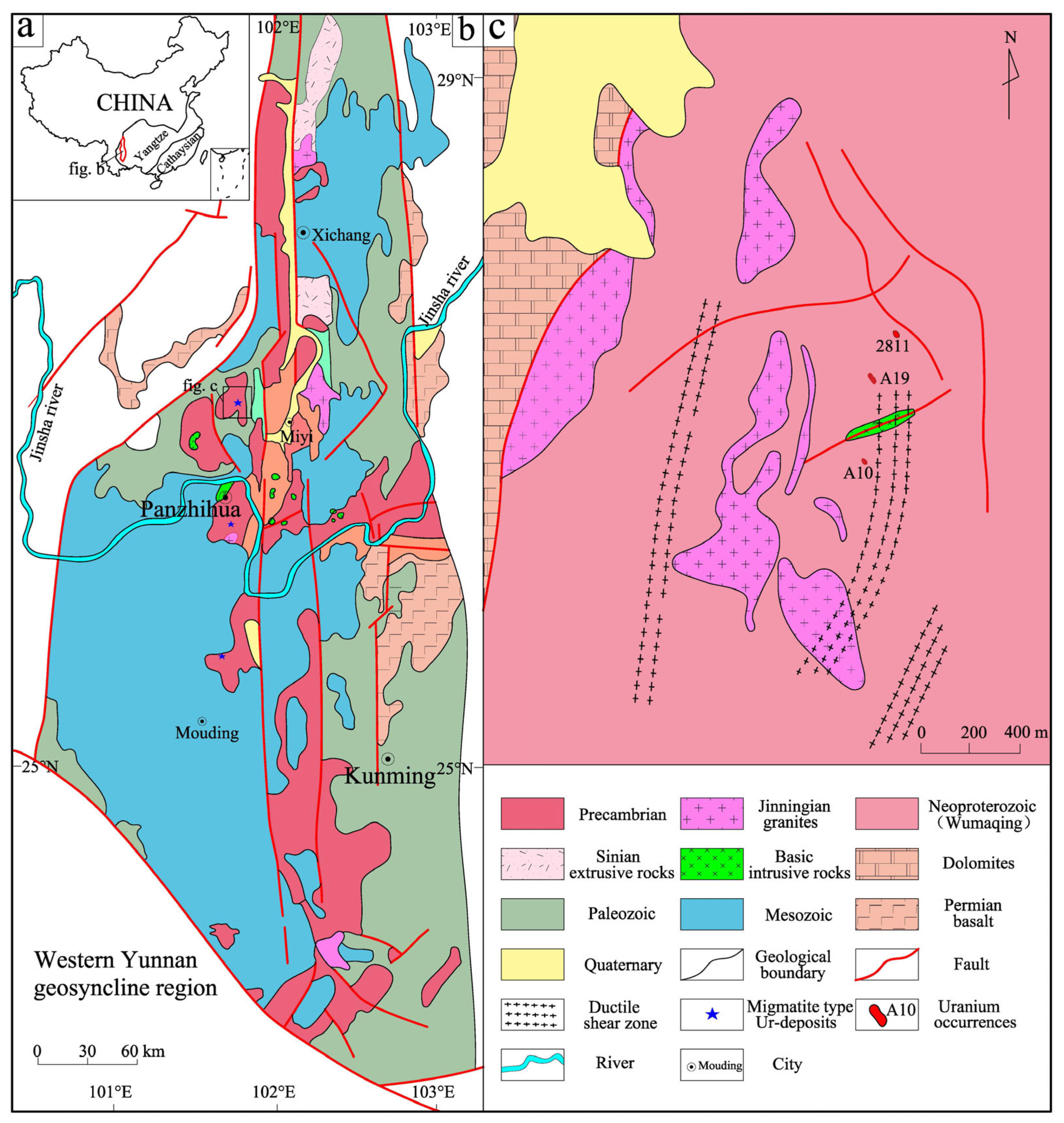
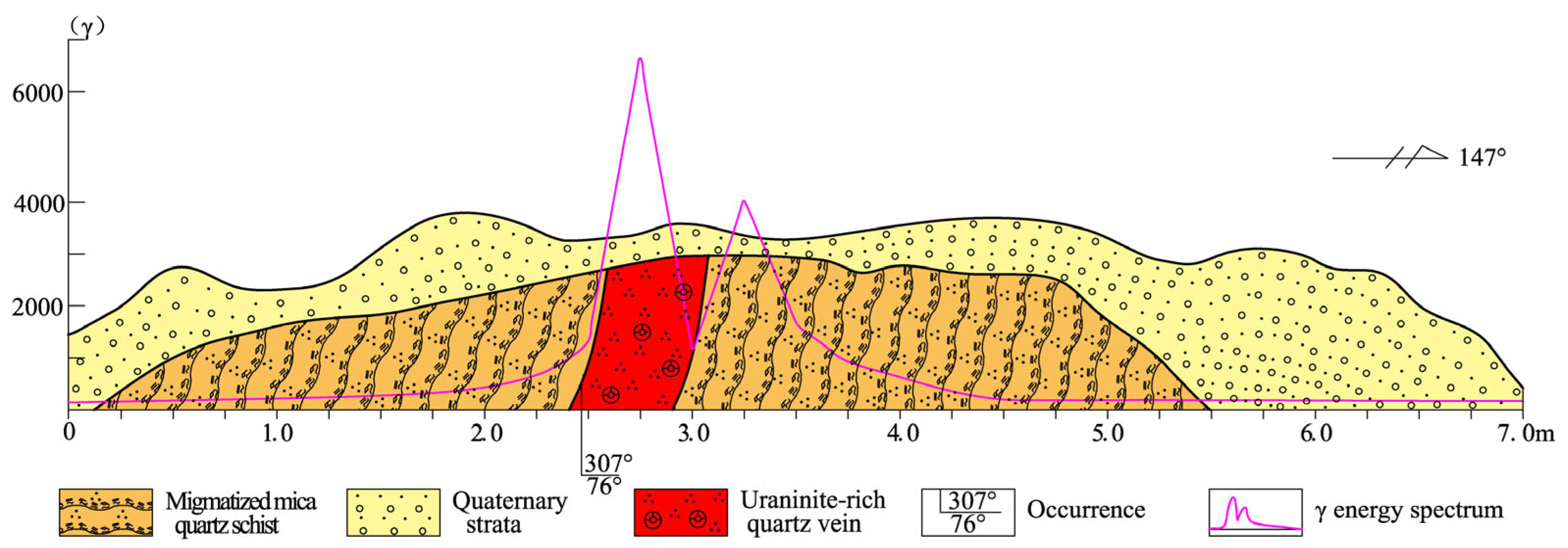
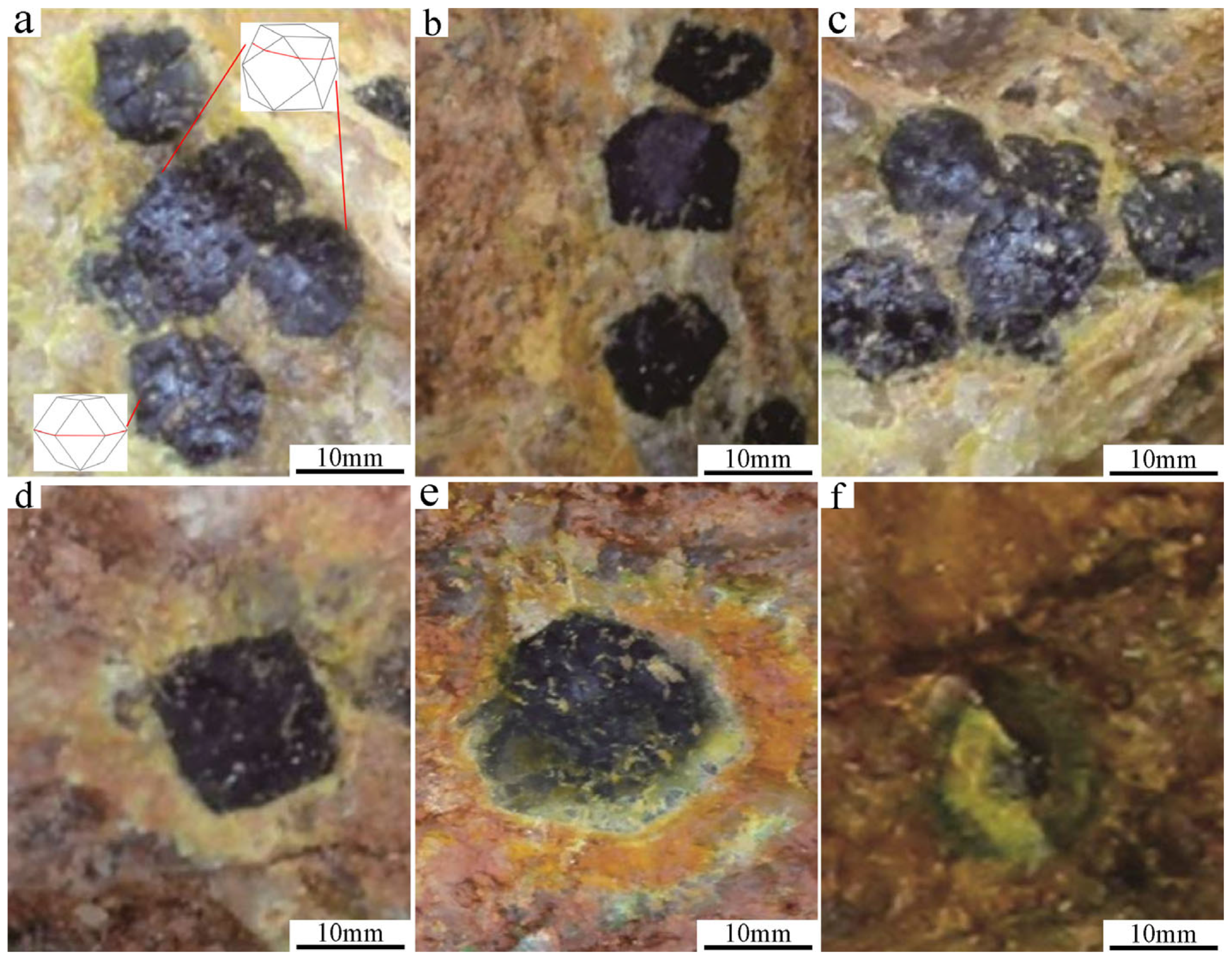
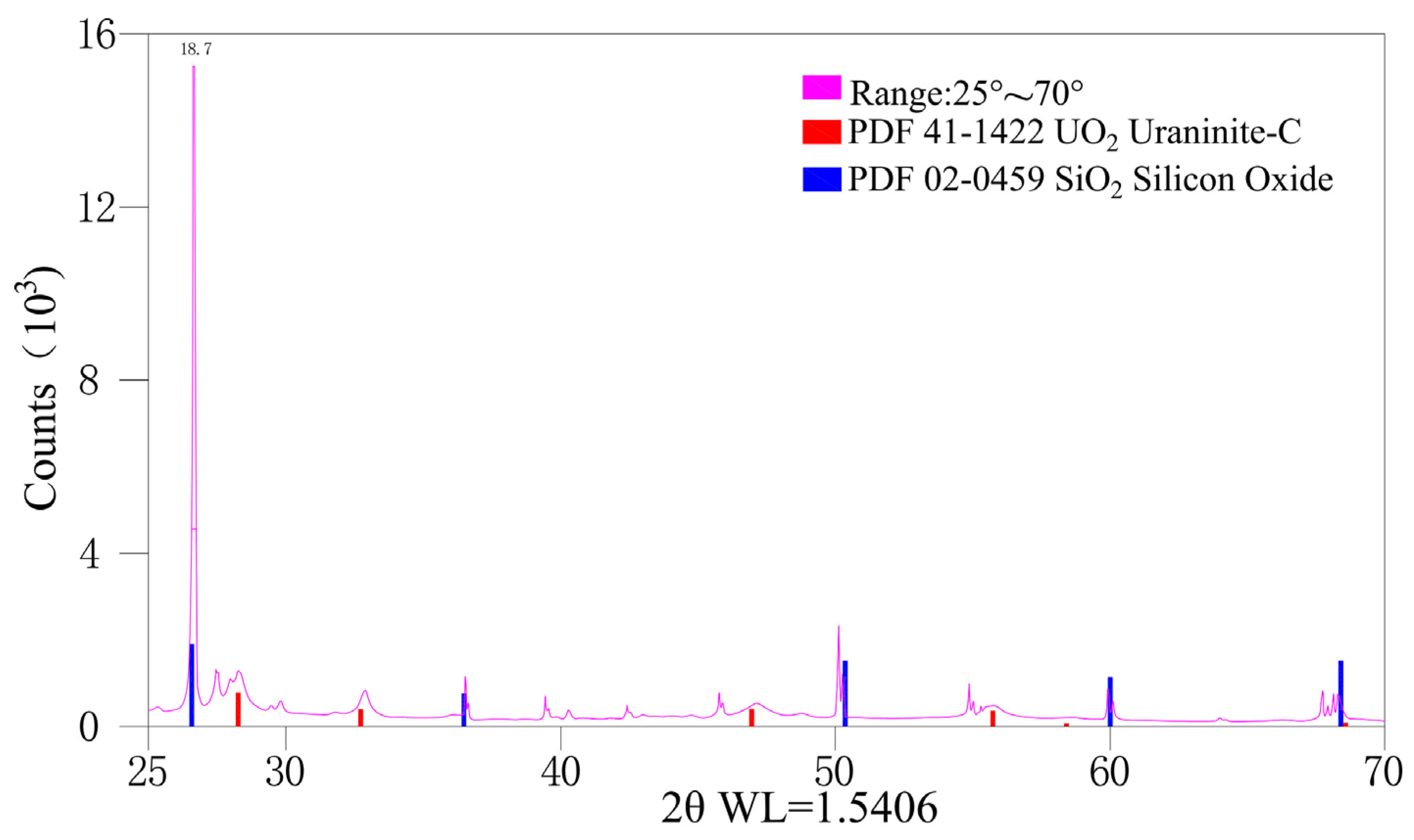
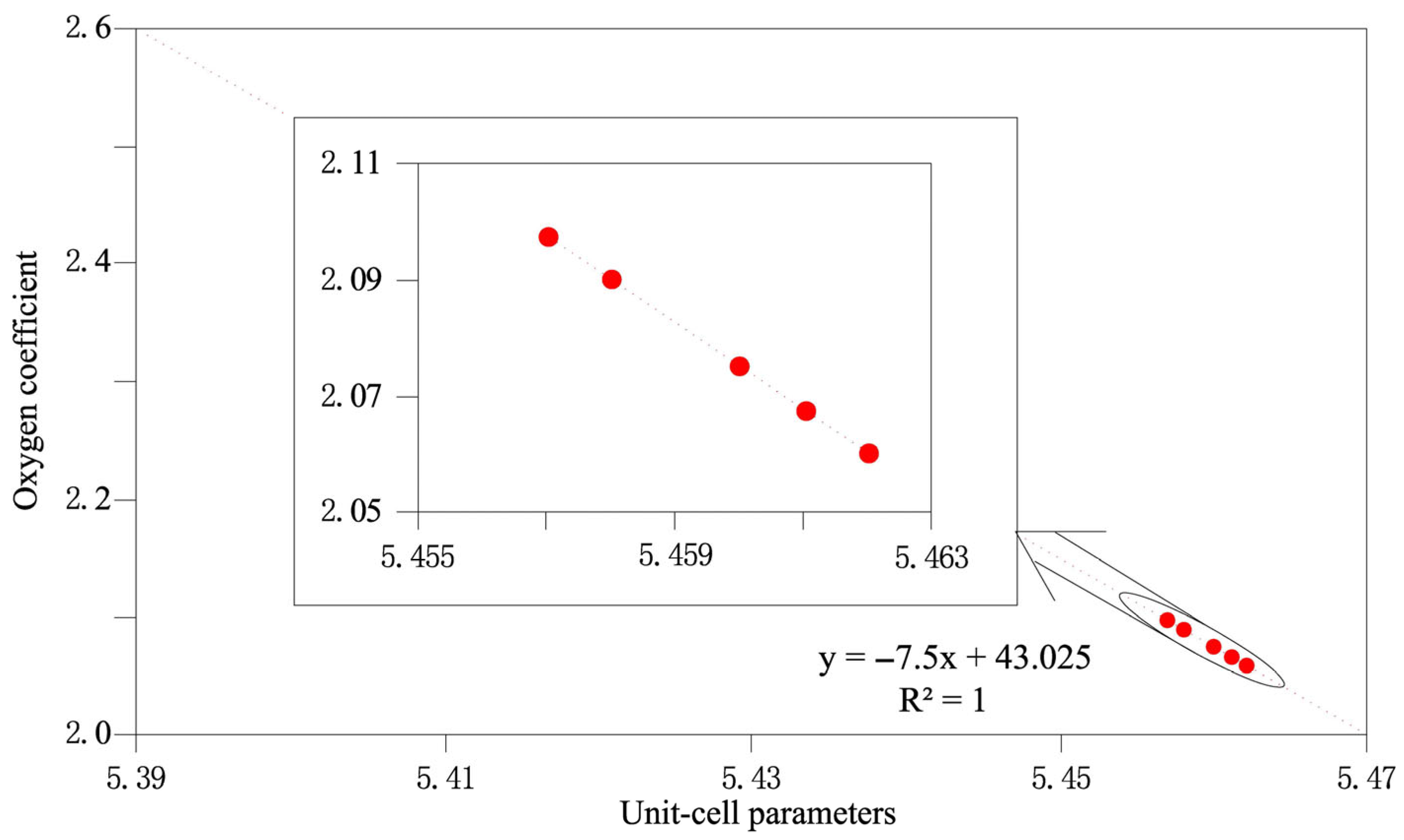
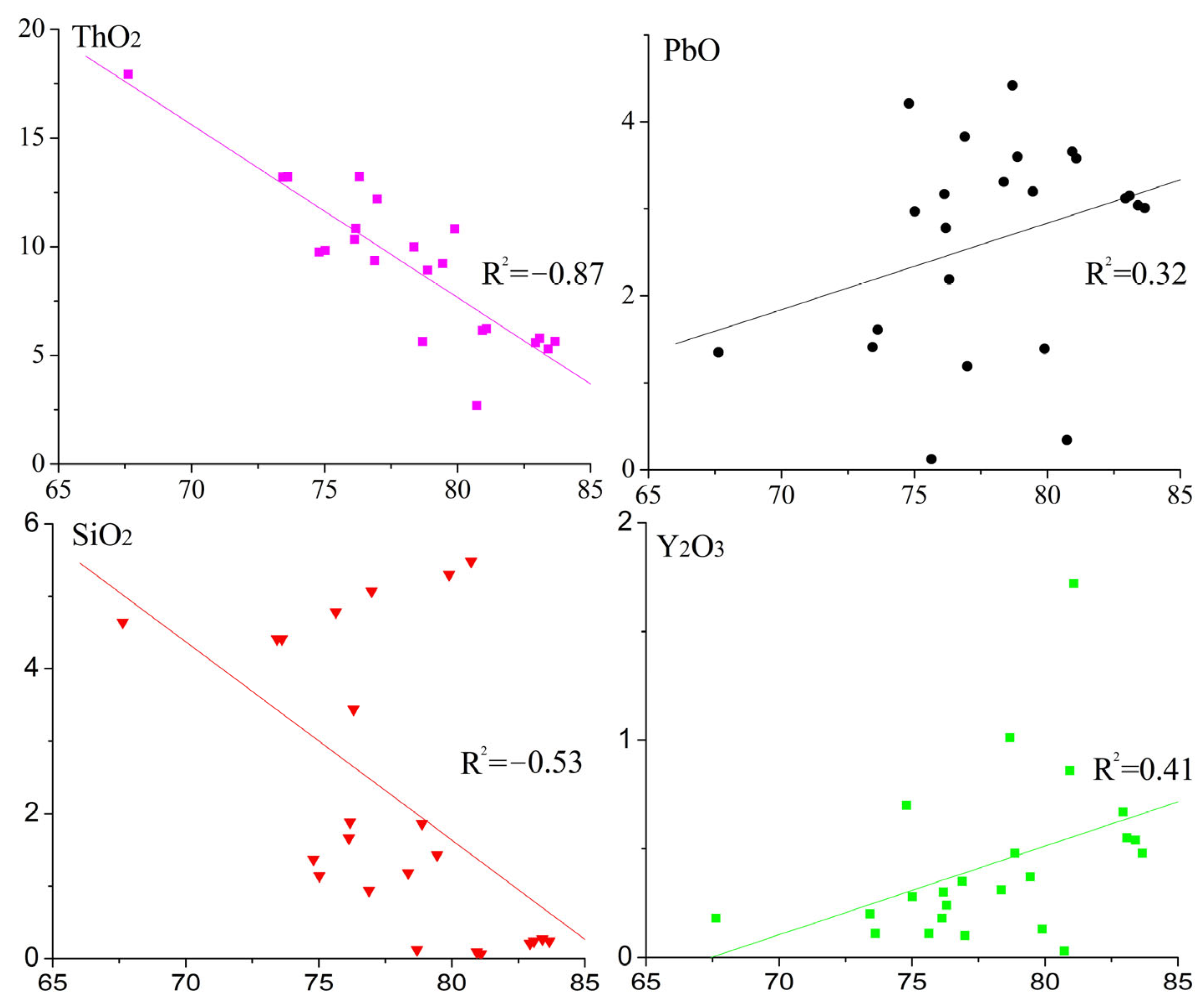


| No. | Reflectance | Mean | |||||||
|---|---|---|---|---|---|---|---|---|---|
| Ht-1 | 14.455 | 14.494 | 13.520 | 13.823 | 14.489 | 14.186 | 15.019 | 14.492 | 14.309 |
| Ht-2 | 14.756 | 13.958 | 13.338 | 13.802 | 15.000 | 14.065 | / | / | 14.153 |
| Ht-3 | 14.665 | 14.328 | 14.761 | 13.267 | 15.647 | 14.597 | 15.145 | 14.167 | 14.572 |
| No. | Grain Size (nm) | Unit-Cell Parameters a0 (Å) | d | hkl | Rwp | Oxygen Coefficient |
|---|---|---|---|---|---|---|
| HT-01 | 15.5 | 5.458 | 3.1294 | {111} | 9.844 | 2.09 |
| 2.7202 | {200} | |||||
| 1.9318 | {220} | |||||
| 1.6435 | {311} | |||||
| 1.5716 | {222} | |||||
| HT-02 | 16.9 | 5.457 | 3.1511 | {111} | 7.566 | 2.0975 |
| 2.7202 | {200} | |||||
| 1.9280 | {220} | |||||
| 1.6408 | {311} | |||||
| 1.5716 | {222} | |||||
| HT-03 | 15.4 | 5.462 | 3.1620 | {111} | 5.387 | 2.06 |
| 2.7122 | {200} | |||||
| 1.9241 | {220} | |||||
| 1.6381 | {311} | |||||
| 1.5691 | {222} | |||||
| HT-04 | 15.6 | 5.461 | 3.1565 | {111} | 7.683 | 2.0675 |
| 2.7162 | {200} | |||||
| 1.9280 | {220} | |||||
| 1.6408 | {311} | |||||
| 1.5716 | {222} | |||||
| HT-05 | 15.0 | 5.460 | 3.1510 | {111} | 7.928 | 2.075 |
| 2.7201 | {200} | |||||
| 1.9318 | {220} | |||||
| 1.6407 | {311} | |||||
| 1.5691 | {222} |
| No. | 101 | 102 | ||
|---|---|---|---|---|
| Valence | U4+ | U6+ | U4+ | U6+ |
| Middle peak | 380.46 | 382.12 | 380.42 | 381.99 |
| Peak width | 2.03 | 1.80 | 1.99 | 2.05 |
| Atomic ratio | 91.57 | 8.43 | 90.32 | 9.68 |
Disclaimer/Publisher’s Note: The statements, opinions and data contained in all publications are solely those of the individual author(s) and contributor(s) and not of MDPI and/or the editor(s). MDPI and/or the editor(s) disclaim responsibility for any injury to people or property resulting from any ideas, methods, instructions or products referred to in the content. |
© 2025 by the authors. Licensee MDPI, Basel, Switzerland. This article is an open access article distributed under the terms and conditions of the Creative Commons Attribution (CC BY) license (https://creativecommons.org/licenses/by/4.0/).
Share and Cite
Yin, M.; Xu, Z.; Xie, B.; Zhang, C.; Yao, J. Typomorphic Characterization and Geological Significance of Megacrystalline Uraninite in the Haita Area, Kangdian Region, Southwestern China. Crystals 2025, 15, 718. https://doi.org/10.3390/cryst15080718
Yin M, Xu Z, Xie B, Zhang C, Yao J. Typomorphic Characterization and Geological Significance of Megacrystalline Uraninite in the Haita Area, Kangdian Region, Southwestern China. Crystals. 2025; 15(8):718. https://doi.org/10.3390/cryst15080718
Chicago/Turabian StyleYin, Minghui, Zhengqi Xu, Bo Xie, Chengjiang Zhang, and Jian Yao. 2025. "Typomorphic Characterization and Geological Significance of Megacrystalline Uraninite in the Haita Area, Kangdian Region, Southwestern China" Crystals 15, no. 8: 718. https://doi.org/10.3390/cryst15080718
APA StyleYin, M., Xu, Z., Xie, B., Zhang, C., & Yao, J. (2025). Typomorphic Characterization and Geological Significance of Megacrystalline Uraninite in the Haita Area, Kangdian Region, Southwestern China. Crystals, 15(8), 718. https://doi.org/10.3390/cryst15080718





